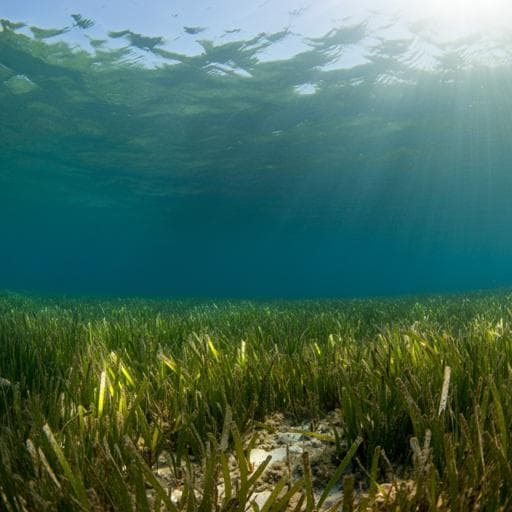
Environmental Studies and Forestry
Rapid sea level rise causes loss of seagrass meadows
K. A. Capistrant-fossa and K. H. Dunton
Discover the alarming trends in global seagrass decline revealed by Kyle A. Capistrant-Fossa and Kenneth H. Dunton. This study uncovers how rising water depths have led to the disappearance of vital seagrass species in the Gulf of Mexico, raising concerns for the future of these ecosystems.
~3 min • Beginner • English
Introduction
Seagrasses are foundational coastal angiosperms that provide extensive ecosystem services and significant blue carbon storage. Despite their importance, global seagrass coverage has declined substantially due to multiple stressors such as eutrophication, heat waves, disease, and physical disturbance. Light availability, strongly modulated by water depth and turbidity, is a key control on seagrass distribution, with deep-edge populations serving as sentinels for environmental change. The Gulf of Mexico has experienced accelerated sea level rise (SLR) since about 2010, likely compounding light limitation in turbid systems. This study investigates whether recent rapid increases in water depth have caused contemporary seagrass loss in a relatively pristine ecosystem. Using two long-term datasets from the Upper Laguna Madre, Texas—a deep edge fixed station (LM-151) monitored since 1989 and a network of 144 sentinel Tier-2 stations sampled annually since 2011—the authors hypothesize that SLR-driven increases in depth reduced bottom irradiance, driving local extirpations at deep edges and broader landscape-scale declines.
Literature Review
The paper reviews that seagrasses occupy about 160,000 km² globally and deliver high-value services including fisheries support, shoreline protection, and carbon sequestration. Seagrass carbon stocks are disproportionately high and can be stored for millennia if undisturbed. However, global coverage has declined by roughly 29% since the mid-1700s, with several species at risk of extinction, returning significant carbon to the active pool annually. Major drivers of seagrass loss include blooms, pollution, disease, drought, eutrophication, heat waves, invasives, mechanical damage, and storms, which often reduce photosynthetic capacity through light limitation or altered metabolism. Seagrasses have high light requirements due to root/rhizome respiration needs in anoxic sediments, and species-specific light tolerances structure communities along depth gradients. Recent work shows accelerated SLR in the Gulf of Mexico, amplified by internal climate variability and local subsidence, potentially increasing water depth and further reducing light. While some models project seagrass distribution shifts under SLR and light attenuation scenarios, empirical long-term demonstrations of SLR-driven deep-edge retreat are scarce; one Mediterranean study hypothesized SLR effects but could not disentangle climate oscillations. This study aims to provide empirical evidence using long-term monitoring.
Methodology
Study area: Upper Laguna Madre (ULM), Texas, a hypersaline lagoon with extensive shallow seagrass meadows, bordered by Corpus Christi and Padre Island National Seashore. Four seagrass species occur, with monitoring focused on Halodule wrightii and Syringodium filiforme.
Monitoring programs: (1) LM-151 deep-edge fixed station (27.35 N, 97.37 W) established in 1989; sampled at roughly monthly intervals for environmental variables and 3–6 month intervals for biomass metrics. (2) Tier-2 network of 144 sentinel stations across ULM sampled annually since 2011 for seagrass presence and water depth.
Environmental measurements at LM-151: Continuous canopy-level PAR measured with a LI-193SA spherical quantum sensor and LI-1000 datalogger since 1989; average daytime irradiance (ADI) computed as monthly means of daytime averages. Routine field visits included measurements of water temperature, salinity (from conductivity), pH, dissolved oxygen, Secchi depth, and total suspended solids (TSS); nutrients (ammonium, dissolved inorganic nitrogen) measured from water samples. Water depth was measured relative to seabed using a marked PVC pole. Epiphyte biomass was periodically quantified from leaf scrapings.
Biological sampling at LM-151: Four haphazard 30-cm deep cores collected every 3–6 months; shoots counted by species, tissues separated into above- and below-ground, dried, and weighed; metrics standardized per m²; shoot density recorded.
Tier-2 sampling: Annual assessments of seagrass presence/absence and water depth at 144 fixed sites. Sites were later clustered by water depth characteristics to interpret patterns.
Data analysis: Visualization with LOESS smoothing for long-term environmental and biological trends. For Tier-2, hierarchical clustering (Ward’s method on Euclidean distance of standardized yearly depth) identified five clusters spanning shallow to deep conditions. Generalized additive models (GAMs, mgcv in R) assessed relationships: gamma family for aboveground biomass vs. environmental predictors (temperature, irradiance, depth), and binomial with logit for presence vs. depth, year, and spatial coordinates; basis functions tuned to avoid overfitting and ensure adequate smoothing. Aboveground biomass chosen as response due to coverage and correlation with belowground biomass; non-significant predictors removed.
Coastwide SLR assessment: Tide gauge data from 54 NOAA stations along the Texas coast (referenced to NAVD88) from 1990–2022, split into pre- and post-2014 periods. For each with ≥5 years data per period, linear regressions of daily maximum tidal height over time estimated relative SLR; non-significant slopes set to zero. LM-151 monthly depth measurements analyzed similarly.
Seagrass habitat change modeling: Three 2050 rSLR scenarios for the Western Gulf of Mexico used: +0.29 m (best), +0.37 m (current/intermediate), +0.49 m (worst). A 1.5 m water depth threshold defined unsuitable habitat based on observed declines in biomass and presence beyond this depth. Newly submerged land estimated using 1 m DEMs to update shoreline position (referenced to mean sea level at the Bird Island Basin gauge during DEM acquisition). 2018 seagrass meadow water depth from Tier-2 informed current conditions. Spatial interpolation and areal calculations performed in ArcGIS Pro.
Key Findings
Environmental trends: At LM-151, water temperatures varied seasonally (approx. 7.8–34 °C) with low interannual variability. Irradiance was lowest in the early 1990s, increased to a plateau around 2000–2015, then declined to the lowest levels since records began. Salinity shifted rapidly in the early 2010s from hyposaline (~17) to hypersaline (~62.6). Water depth significantly increased since 2014 at LM-151 at 14 mm yr−1 (p = 0.02). Across Texas NOAA stations, relative SLR rates were low pre-2014 (up to 9 mm yr−1), then increased significantly post-2014 at most stations (3–21 mm yr−1).
Biological responses at LM-151: From 1989–2005 the site was nearly monotypic Halodule; Syringodium recruited in 2005, exceeded Halodule biomass in the early 2010s, then retreated and was absent by 2013. Halodule did not recover to pre-2010 levels and disappeared by 2018. Biomass ratios indicated Syringodium lost aboveground tissues first (acute stress), while Halodule showed patterns consistent with chronic stress (declining below:aboveground ratio).
Tier-2 network: Depth-based clustering revealed five site groups (means ~0.45–1.66 m). Seagrass presence declined most in the deepest sites (Cluster 5): presence at 80% of sites in 2013 dropped to 4% by 2022. Cluster 2 (intermediate depths) maintained the highest presence (259/261 samples), while Cluster 5 had the lowest (130/261). GAMs showed presence at Tier-2 sites was significantly affected by water depth, year, and spatial location (R² = 0.62); depths >1.5 m strongly reduced presence probability, with some interannual variability. Seagrass was more likely in the northeastern ULM and least likely in the south.
Drivers and modeling: At LM-151, GAMs identified water temperature and bottom irradiance as significant predictors of aboveground biomass for Syringodium (R² = 0.68) and Halodule (R² = 0.31), with narrower optima for Syringodium (25–30 °C, ≥365 µmol photons m−2 s−1). Water depth and irradiance best explained Syringodium presence (R² = 0.22). Declining PAR since ~2012 coincided with rising water depth. A ~0.25 m increase in depth would reduce bottom light by 25–50% (for K values typical of ULM), sufficient for deep-edge extirpation.
Habitat extent: Historically up to ~200 km² of seagrass in Upper Laguna Madre. By 2018, suitable habitat (<1.5 m) decreased by >41 km². Under 2050 scenarios, unsuitable habitat (≥1.5 m) expands to ~73–113 km², while newly submerged shallow habitat could be ~90–135 km², yielding a potential net gain of ~59–66 km²; however, actual expansion is constrained by shoreline hardening and other factors. Globally, an estimated ~14,000 km² of seagrass meadows occur in turbid waters (K > 1) and may be especially susceptible to SLR.
Discussion
The synthesis of three decades of deep-edge monitoring with a basin-wide sentinel network demonstrates that rapid SLR since 2014 increased water depths, reduced bottom irradiance, and precipitated the loss of deep-edge seagrasses in a relatively pristine system. Species-specific responses reflected physiology and successional dynamics: Syringodium, with narrower environmental optima, expanded then collapsed under hypersalinity and did not recolonize as depth-driven light limitation intensified; Halodule, a pioneer species with broader tolerances, declined more gradually but ultimately disappeared from the deep edge with chronic light stress. The absence of consistent long-term trends in temperature or sustained eutrophication signals, coupled with stable epiphyte loads and the timing of nutrient increases after biomass loss, point away from eutrophication as the primary driver. Instead, chronic depth increase integrates multiple processes (e.g., stratification, temperature effects) but most critically diminishes light delivery to the benthos in turbid waters, crossing physiological thresholds for persistence. Landscape-scale analyses corroborate the LM-151 pattern: presence declines were strongest at deeper Tier-2 sites, with a clear depth threshold around 1.5 m. While models suggest potential gains in future shallow habitat as shorelines inundate, expansion is limited by shoreline hardening and other environmental constraints. The findings provide rare empirical evidence of contemporary SLR impacts on seagrass distributions and underscore global risks, particularly in turbid systems, adding SLR to the list of stressors (storms, eutrophication, disease, heat waves) already imperiling seagrass meadows.
Conclusion
This study provides long-term empirical evidence that recent acceleration in sea level rise has increased water depths and reduced bottom light, causing rapid loss of deep-edge seagrass meadows in the Upper Laguna Madre and widespread declines across deeper sites basin-wide. Integrating a high-frequency, decades-long fixed station with a coast-wide sentinel network and statistical modeling, the authors identify depth- and light-driven thresholds for seagrass persistence and quantify present and future habitat shifts under SLR scenarios. Although models indicate potential gains in shallow habitat with inundation, actual colonization will be constrained by shoreline hardening and local environmental conditions, suggesting net losses in many regions. Globally, large areas of seagrass in turbid waters are vulnerable to accelerated SLR, threatening ecosystem services and blue carbon storage. Future work should extend similar long-term monitoring and depth–light threshold analyses to other regions, incorporate dynamic shoreline and marsh accretion processes, evaluate management strategies to reduce shoreline hardening, and explore adaptive policies to maintain water clarity and facilitate seagrass migration.
Limitations
Estimated relative sea level rise rates from tide gauges may overpredict true rates because the geodetic reference does not fully account for processes like subsidence or sediment accretion. The recent acceleration in SLR attributed to internal climate variability (e.g., Rossby waves) is likely short-lived, potentially complicating extrapolation. Habitat expansion estimates represent upper bounds; actual colonization may be lower due to environmental constraints and widespread shoreline hardening. Marsh dynamics introduce uncertainty, as marshes may or may not keep pace with SLR via accretion. Statistical models were limited in the number of predictors due to data coverage and power, and Tier-2 analyses focused primarily on water depth, potentially omitting other relevant co-varying factors. The study is observational, so unmeasured confounders cannot be entirely ruled out.
Related Publications
Explore these studies to deepen your understanding of the subject.







